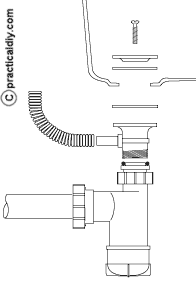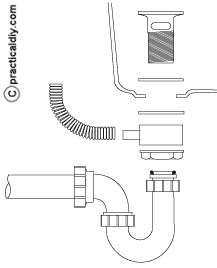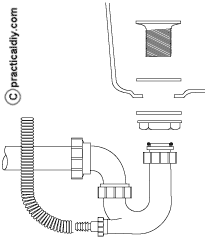Waste fittings on metal sinks
Modern metal are usually made from stainless steel and do not have a built in overflow - older sinks sometimes have an overflow built and the installation of the waste water outlet is similar to that shown for hand basins.
This article details fitting the waste outlets for modern metal sinks with just a hole, not with an integral overflow.
The standard waste outlet holes in sinks is 38mm (1½ inch) however, where sinks are designed to take under sink waste disposal units, the hole may be 89mm (3½ inch).
To avoid having to work in confined areas after installation, it is usually much easier to fit the waste fittings and overflow to the sink before it is fitted.
Waste fittings for modern sinks with 38mm (1½ inch) waste holes are fairly standard but there are various options to choose from for the plug hole fitting - the options are just different, none is really better than any other.
In the illustrations below, a washer is shown inside the sink, under the outlet, if the outlet kit does not include a washer for here, apply some plumbers sealant (Plumbers Mate or similar) around the underside of the outlet rim before assembling it to the sink and after the outlet has been tightened to the sink, wipe off any surplus sealant from around the outlet inside the sink.
Outlet with adapter
 The
easiest sink waste outlet is probably using an adapter beneath the sink. This adapter is secured to the underside of the sink by a screw through the middle of the waste grille into the centre of the adapter.
The
easiest sink waste outlet is probably using an adapter beneath the sink. This adapter is secured to the underside of the sink by a screw through the middle of the waste grille into the centre of the adapter.
As the screw is tightened, the washers are compressed and give a watertight seal.
Washers are usually positioned under the grille (inside the sink) and between the underside of the sink and the adapter.
The adapter incorporates an inlet to take the flexible pipe from the sink overflow. The inlet needs to be positioned so that it is convenient for connecting the pipe from the overflow.
Any type of waste trap can be fitted - a bottle trap is shown to the right while below a 'P' trap is illustrated and the choice includes an 'S' trap. The type of trap actually fitted may depend upon space under the sink or the direction of the waste water pipe run.
Outlet with banjo
 Another
option for sink waste fittings uses a deep plug hole outlet with a long threaded body with slots in the sides to take any water from the overflow.
Another
option for sink waste fittings uses a deep plug hole outlet with a long threaded body with slots in the sides to take any water from the overflow.
A 'banjo' fitting fits over the plug hole outlet fitting and both are secured by a large nut fitted to the outlet against the underside of the banjo. The 'banjo' provides the connection for the flexible pipe from the overflow.
After assembling the outlet, washers and 'banjo', apply some plumbers sealant around the screw thread on the outlet so that it will fill the thread of the large nut.
The inlet to the banjo needs to be positioned so that it is convenient for connecting the pipe from the overflow.
The large nut needs to be tightened to compress the washers to provide a watertight seal. Some banjos are made of plastic, a little care needs to be taken when tightening the nut down onto one of these to avoid overtightening and damaging the banjo.
Washers are usually located under the plug hole outlet (inside the sink) and between the underside of the sink and the banjo.
Outlet with overflow into trap
 Another
method is to use a short sink outlet fitting secured to the sink by a nut and with the pipe from the overflow connected to an inlet on the waste trap. This type of arrangement cannot be used with a bottle waste trap.
Another
method is to use a short sink outlet fitting secured to the sink by a nut and with the pipe from the overflow connected to an inlet on the waste trap. This type of arrangement cannot be used with a bottle waste trap.
The nut is tightened to the underside of the sink and compresses the washers to give a watertight seal.
Washers are usually fitted under the sink outlet and between the underside of the sink and the nut.
Overflow fitting
 The
sink waste overflow is usually fairly standard, the grille of overflow fits against the inside of the sink and is screwed into the overflow which is connected which is connected to a flexible pipe to the underneath the sink. To tighten the grill it may help to use the jaws of a pair of long nosed pliers carefully inserted into the grille to get a better hold - do not use too much force as the grill can easily be damaged.
The
sink waste overflow is usually fairly standard, the grille of overflow fits against the inside of the sink and is screwed into the overflow which is connected which is connected to a flexible pipe to the underneath the sink. To tighten the grill it may help to use the jaws of a pair of long nosed pliers carefully inserted into the grille to get a better hold - do not use too much force as the grill can easily be damaged.
A washer is normally located between the side of the sink and the grille to give a water seal.
